New Interventional Radiology Suite offers state-of-the-art care
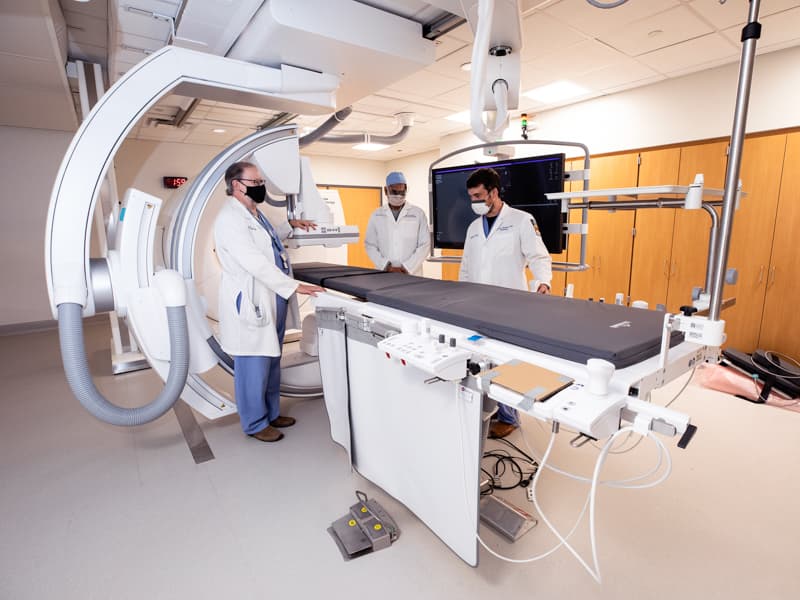
When the new Interventional Radiology Suite opens next month at the University of Mississippi Medical Center, already stellar care will be enhanced by the latest technology in a spacious and inviting treatment area.
That’s a big change over the former cramped space for diagnostic and outpatient procedures provided by a team that includes seven interventional radiologists, two neurosurgeons, two nurse practitioners, a dozen registered nurses, and a dozen highly trained technologists.

“State of the art probably doesn’t adequately cover how magnificent this facility is,” said Dr. Timothy McCowan, professor and chair of the Department of Radiology.
A ribbon-cutting ceremony on Aug. 25 introduced the new suite, the culmination of several years of construction. Interventional Radiology, or IR, is located on a lower level of University Heart. The IR Suite is set for a post-Labor Day opening.
Interventional radiology is a sub-specialty of radiology in which imaging technology – MRI, CT and PET scans, ultrasound and X-ray – are used to guide minimally invasive procedures that include cancer biopsies, challenges encountered by liver transplant and kidney dialysis patients, injection of chemotherapy drugs, venous access lines and more.
“We cover the entire body, almost head to toe,” McCowan said. Compared to an open surgery, IR procedures are “quicker, simpler, less invasive, less risky, require less recovery time and are less expensive.
“We provide direct, face-to-face, hands-on care of patients who trust us with their health, and sometimes, their lives.”
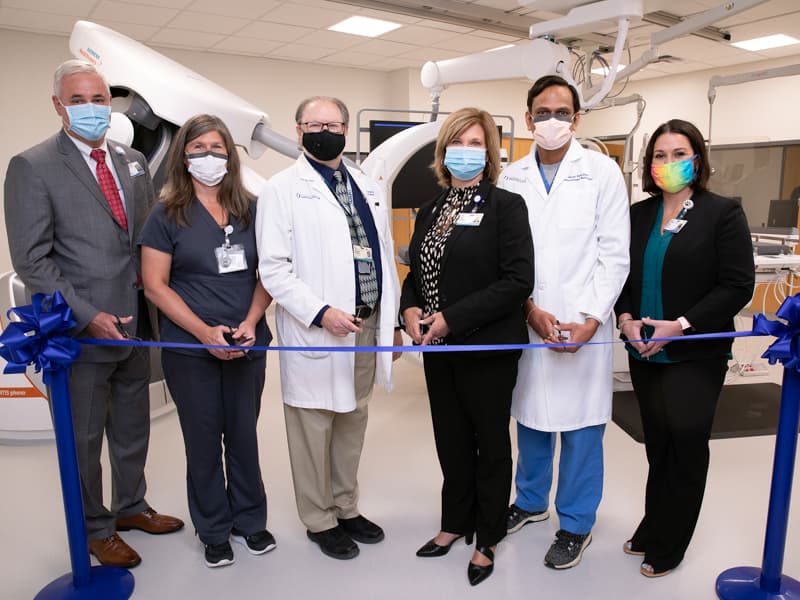
Treatment requires one or all of multiple components that include pre-procedure evaluations, procedure rooms, post-procedure recovery, rooms where providers read scans, and multiple staff work areas.
“The way we have our workflow configured is fairly unique,” said Dr. Akash Patel, associate professor and chief of the Division of Interventional Radiology. He believes fewer than 10 centers in the nation have the same aggregate setting.
When those awaiting outpatient procedures arrive at the circular drive fronting University Heart, they’ll have easy drop-off and pick-up. They will be greeted in a comfortable, modern waiting area, then escorted to the IR Suite. “It’s completely dedicated to hands-on care,” McCowan said
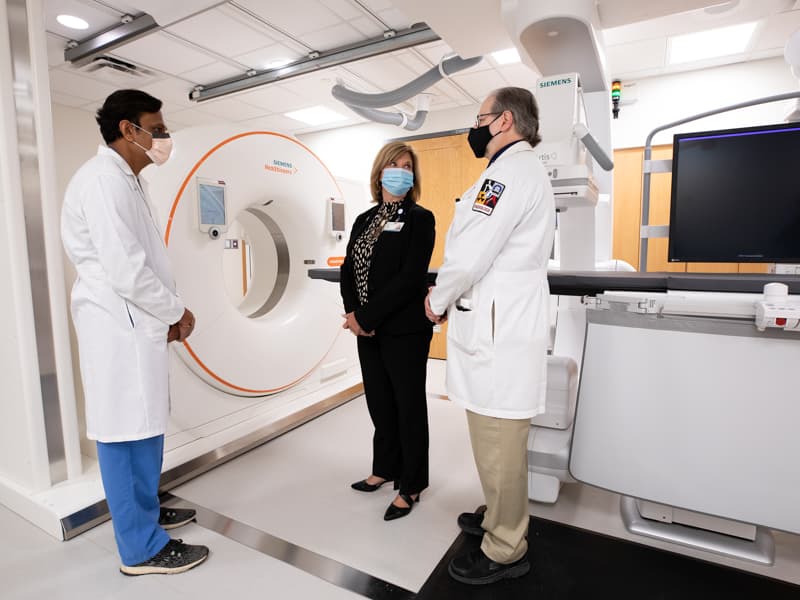
Treatment takes place in one of six procedure rooms; before that, patients will wait in their own pre-procedure space equipped with cutting-edge monitoring equipment. Following procedures, patients are wheeled to a recovery area, either in the IR Suite or University Hospital, depending on their needs and complexity of their procedure.
One example of treatment in the IR Suite would be care to extend the life of liver cancer patients in need of a transplant, Patel said. “Because of the size or location of the cancer, they might not qualify for a liver transplant,” he said.
“We can shrink the tumor so that they qualify for the transplant, and most of the time, that will change a person’s life. That can mean 10 more years of quality of life.”
Another combined treatment is use of CT scanning in addition to fluoroscopy, a study of moving body structures used in procedures that include catheter insertion and manipulation. It involves passing a continuous X-ray beam through the body part requiring the procedure, with the beam appearing on a video monitor to see the area in detail.
The IR Suite is home to not just one, but two CT-fluoroscopy imaging systems, each in its own room. UMMC is one of few, if not the only, interventional radiology suites nationally with two, Patel said.
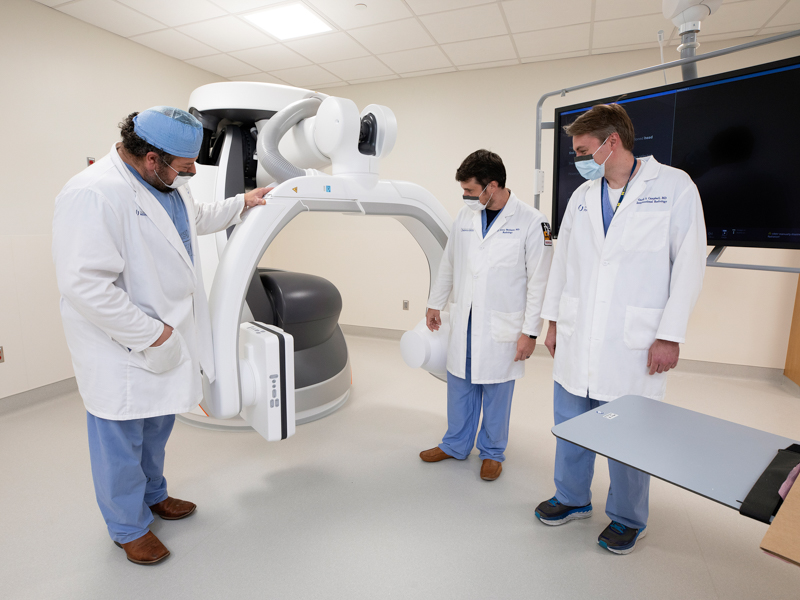
Equipment used in procedures “includes some that is fairly new and unique for Mississippi,” McCowan said. “It allows more precise targeting for treatment. For example, we can use the power of both CT scanning and regular X-ray to be more precise, safe and effective.”
One of the IR Suite’s six X-ray units “employs a design similar to an industrial robot,” he said. “It allows for a variety of positioning options for procedures.”
Each interventional radiologist has a subspecialty area. For Patel, it’s complex hepatobiliary and oncology interventions. The others include Dr. Mohammad Ali, interventional oncology and uterine artery embolization; Dr. Garth Campbell, embolotherapy and interventional oncology; Dr. J. Henry Williams, spine interventions and renal cryoablation; Dr. Ajinkya Desai, complex venous intervention; and Dr. Jay Vasani, prostate artery and uterine artery interventions.
IR works very closely with endovascular neurosurgery, a sister specialty to interventional radiology, McCowan said. Using a paired two-unit X-ray machine, endovascular neurosurgeons treat diseases such as stroke or brain aneurysms, McCowan said.
IR cares for “people who are extremely healthy, and people who are extremely ill,” McCowan said. “We treat patients who have been in traumatic accidents and who have suffered broken bones or bleeding organs. We put plugs in a patient’s blood vessels to keep them from bleeding to death.”
The new IR Suite works seamlessly with an interventional radiology clinic in University Pavilion, McCowan said. “Depending on the procedure, patients might first see us to discuss it, or referred by another physician for a procedure,” he said. “The vast majority of IR patients are referred from other providers, both inside UMMC or throughout the state.”
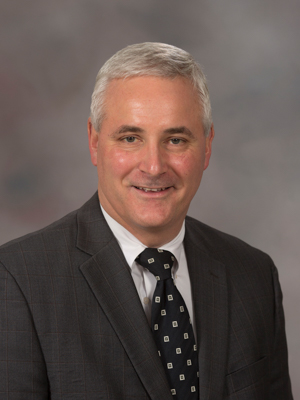
“This is a glorious occasion,” Britt Crewse, chief executive officer of UMMC’s adult hospitals, said at the ribbon-cutting celebration.
Crewse said the facility reminds him of one of the Medical Center’s values: innovation. ‘What we have here today is very new, and very innovative,” he said.
The new IR Suite was well worth the wait, McCowan said.
“It’s the epitome of modern medicine to use minimally invasive techniques,” McCowan said. “It was a massive project to upgrade and improve IR. Now, everything is ready for our patients.”


